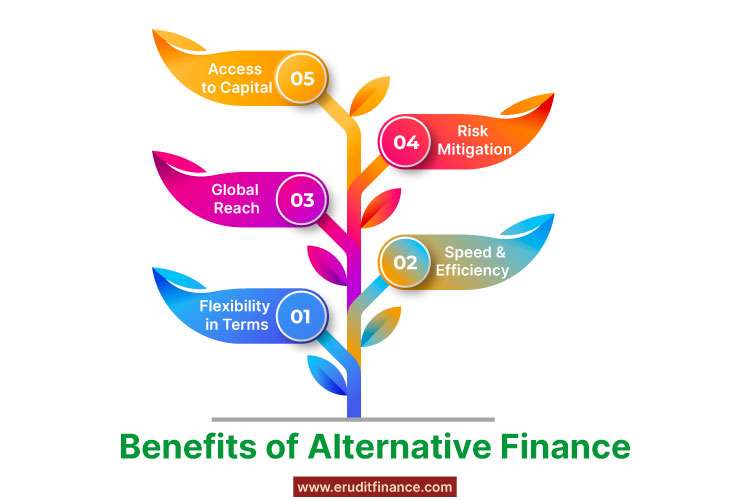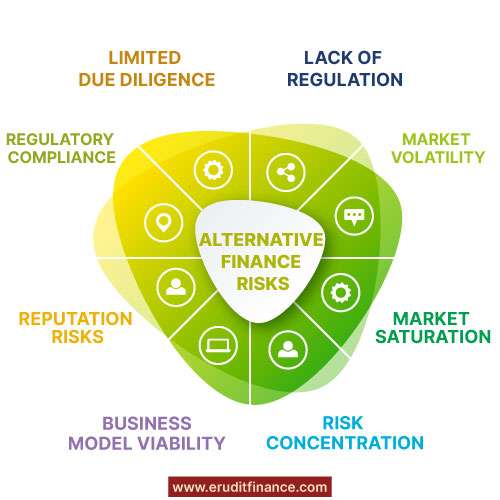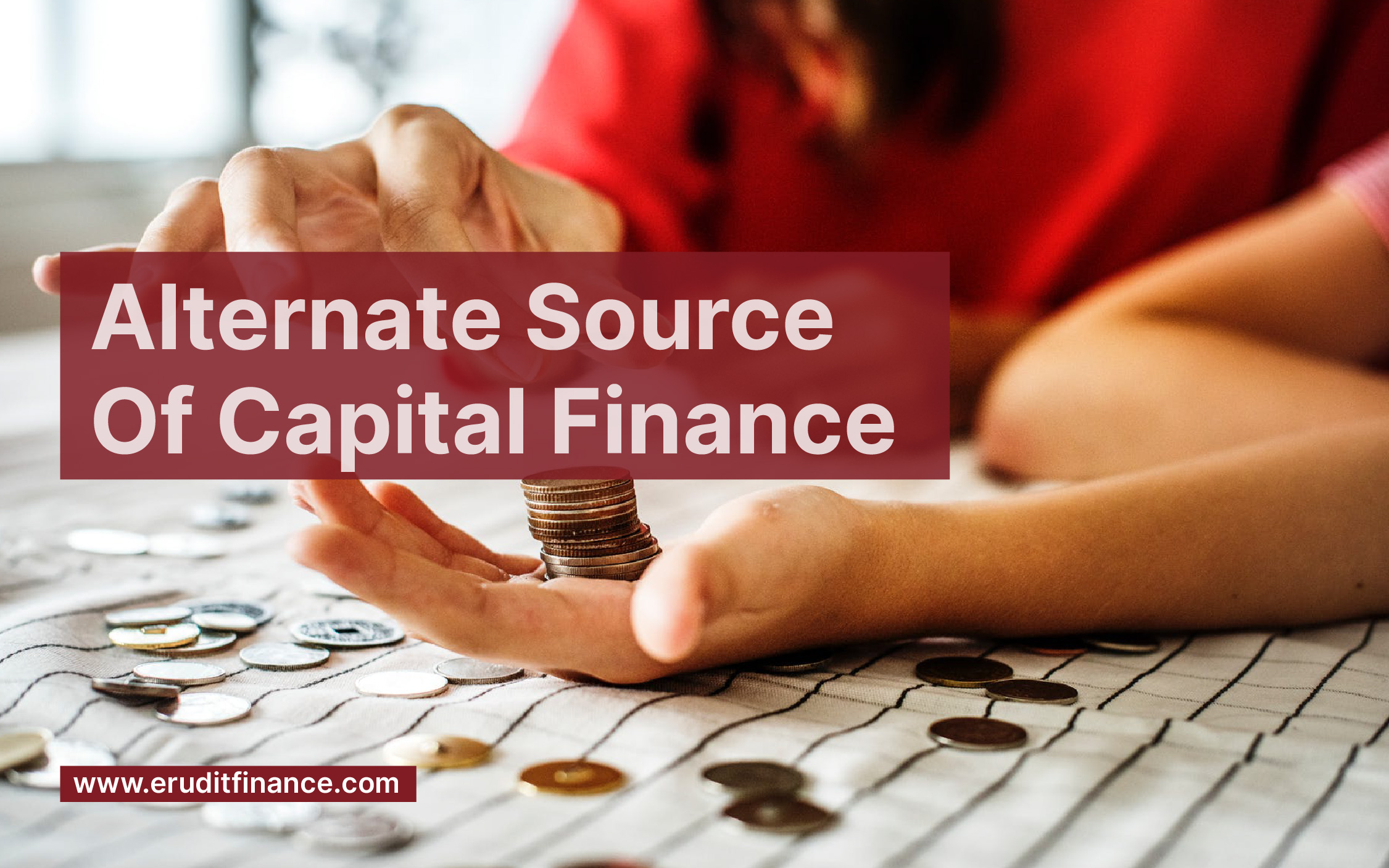In the dynamic landscape of business, seeking alternative sources of finance beyond traditional avenues is essential. These alternatives offer diverse funding options that can cater to specific needs, promoting financial flexibility and strategic growth. From venture capital and crowdfunding to trade credit and lease financing, exploring these alternatives provides businesses with a broader financial toolkit. This introduction delves into the significance of seeking alternative sources of finance, highlighting the versatility and potential advantages they offer in navigating the complex terrain of modern financial landscapes.
What Is the Most Popular Form of Alternative Financing?
Various forms of alternative financing have gained popularity, making it challenging to pinpoint the single most popular form. However, some commonly favored alternatives include
| Venture Capital | Crowdfunding | Equipment Financing |
| Peer-to-Peer Lending (P2P) | Angel Investors | Revenue-Based Financing |
| Invoice Financing | Alternative Lenders | Government Grants & Subsidies |

The popularity of these forms varies based on factors like industry, business stage, and economic conditions.
It’s essential to assess the specific needs and circumstances of a business to determine the most suitable alternative financing option.
Keep in mind that the popularity of financing methods can change over time due to evolving market trends and regulatory environments.
How Does Alternative Finance Work?
Alternative finance encompasses a diverse range of funding methods beyond traditional banking. Here’s a general overview of how some common forms of alternative finance work.

Venture Capital- Venture capitalists invest in startups and high-growth companies in exchange for equity. They typically seek significant returns and often provide expertise and guidance.
Crowdfunding- Funds are raised by small contributors from a large number of individuals and businesses via the Internet. For instance, it may be rewards-based (backers get a product or service) or equity-based in terms of backers being shareholders.
Peer-to-Peer Lending (P2P)- P2P lending platforms connect borrowers with individual lenders. Borrowers receive loans funded by multiple individuals, while lenders earn interest on their investments.
Angel Investors- Angel investors are individuals who invest their own money in startups in exchange for convertible debt or equity. They often provide mentorship and guidance to the businesses they invest in.
Invoice Financing- Businesses sell their unpaid invoices to a third party (factor) at a discount. This provides immediate cash flow while the factor collects the full invoice amount from the debtor.
Alternative Lenders- Non-bank lenders, including online lenders and fintech companies, offer various loan products with different terms than traditional banks. The application and approval processes are often faster and more flexible.
Cryptocurrency & Blockchain Funding- Initial Coin Offerings (ICOs) and Security Token Offerings (STOs) involve fundraising through the issuance of digital tokens on blockchain platforms, providing investors with a stake in the project or specific rights.
Revenue-Based Financing- Businesses receive cash from investors who take part in the profits later on. This form of finance allows for linking payments with the company’s income rather than issuing more debt or selling additional equity.
Equipment Financing- Businesses secure financing specifically for the purchase of equipment. The equipment itself serves as collateral, and repayments are structured based on the asset’s lifespan.
Government Grants and Subsidies- Government agencies provide businesses with funds for certain activities, sectors, and projects. Such funding may appear as grants, subsidies, or low-interest loans.
It is important to understand how each specific term, condition, or implication is involved in the alternative financial methods. Businesses must also be cautious about their requirements, financial position, and type of financing option before following alternative financing approaches.
What Is the Future of Alternative Finance?
The future of alternative finance holds significant promise and is expected to continue evolving in response to changing economic landscapes, technological advancements, and shifting preferences in the financial industry. Several trends and potential developments indicate the direction of alternative finance.

1). Fintech Innovation- Ongoing fintech innovations are likely to introduce new and improved alternative finance platforms, streamline processes, enhance user experiences, and expand the range of available financial products.
2). Blockchain and Cryptocurrency Integration- Increased integration of blockchain technology and the use of cryptocurrencies may reshape fundraising methods, with tokenization playing a more prominent role in investment and fundraising processes.
3). Regulatory Frameworks- As governments and regulatory bodies adapt to the evolving landscape, clear and supportive regulatory frameworks for alternative finance are expected to emerge. This could foster greater investor confidence and participation.
4). Diversification of Funding Sources- Businesses and individuals are likely to increasingly diversify their funding sources, leveraging a mix of traditional and alternative finance options to meet their unique needs and capitalize on available opportunities.
5). Greater Accessibility- Advances in technology, including mobile applications and digital platforms, will likely contribute to greater accessibility of alternative finance options, enabling a more inclusive approach to funding for a wider range of businesses and individuals.
6). Sustainable Finance- The future of alternative finance may see an increased focus on sustainable and impact investing. Investors may prioritize projects and businesses aligned with environmental, social, and governance (ESG) criteria.
7). Tokenization of Assets- The tokenization of various assets, including real estate and commodities, could become more prevalent. This may provide increased liquidity and accessibility to traditionally illiquid assets.
8). Decentralized Finance (DeFi)- The rise of decentralized finance (DeFi) platforms, operating on blockchain networks, could revolutionize traditional financial services, offering decentralized lending, borrowing, and other financial activities.
9). Artificial Intelligence (AI) Integration- AI applications may play a more significant role in alternative finance, enhancing risk assessment, fraud prevention, and customer experiences. AI-driven algorithms could contribute to more accurate decision-making processes.
10). Evolution of Crowdfunding Models- Crowdfunding models may evolve, incorporating new structures and hybrid models that combine elements of debt, equity, and reward-based crowdfunding, providing increased flexibility for both fundraisers and investors.
11). Global Expansion- The global spread of alternative finance is also bound to continue manifesting in enhanced cross-border investments coupled with various fundraising campaigns.
The future for alternative finance has considerable prospects but is itself vulnerable to further innovations, governmental reforms, economy-related matters, and major scientific achievements. However, success relies on change adaptation as well as the utilization of new chances associated with the changeability of alternative financing itself.
What Are the Main Benefits of Alternative Finance?
Alternative finance offers a range of benefits that appeal to businesses, entrepreneurs, and investors seeking diverse funding options beyond traditional channels. Here are some main advantages.
| Access to Capital | Global Reach | Speed and Efficiency | Flexibility in Terms |
| Risk Mitigation | Broadened Investor Base | Leveraging Asset Value | Access to Niche Markets |
| Technology Integration | Responsive to Market Trends | Democratization of Finance | Diversity of Funding Sources |

Access to Capital- Alternative finance provides access to funding for businesses that may face challenges securing loans from traditional banks, especially startups, small businesses, or those with unconventional models.
Diversity of Funding Sources- Businesses can diversify their funding sources by exploring alternative finance options and reducing dependency on traditional loans or equity financing.
Speed and Efficiency- Many alternative finance platforms leverage technology for quick and streamlined processes, allowing for faster approval and funding compared to traditional financial institutions.
Flexibility in Terms- Alternative finance often offers more flexible terms, allowing businesses to negotiate terms that better suit their unique needs and circumstances.
Innovation and Technology Integration- Fintech innovations and technology integration characterize alternative finance, enhancing user experiences, improving efficiency, and providing innovative financial solutions.
Broadened Investor Base- Crowdfunding and peer-to-peer lending platforms attract a diverse pool of investors, expanding opportunities for businesses to connect with a wide range of funders.
Access to Niche Markets- Businesses with specialized or niche offerings may find alternative finance platforms that cater specifically to their industry or target market.
Leveraging Asset Value- Financing options like invoice financing and asset-based lending allow businesses to leverage their assets, such as outstanding invoices or equipment, to secure funds.
Risk Mitigation- For investors, alternative finance offers opportunities to diversify their portfolios, spreading risk across a range of investments rather than relying solely on traditional markets.
Responsive to Market Trends- Alternative finance is often more responsive to market trends, allowing businesses to quickly adapt to changing economic conditions or capitalize on emerging opportunities.
Democratization of Finance- Crowdfunding and peer-to-peer lending democratize finance, providing individuals with the opportunity to invest in projects and businesses they believe in, irrespective of their financial status.
Global Reach- Many alternative finance platforms operate globally, facilitating cross-border investment and fundraising opportunities, and promoting international collaboration.
Though these advantages may be attractive, the business and investors need to take time and carefully consider the special terms, risks as well and suitability of alternative financing for their different conditions.{ Alternative Finance constantly defines the new world of finance opening up fresh prospects in investment for everyone interested.
What Are Alternative Finance Risks?
Despite the advantages, alternative finance comes with its set of risks and challenges. Businesses and investors must be aware of these potential pitfalls. Here are some key alternative finance risks.

a). Lack of Regulation: Some alternative finance sectors, especially emerging ones like cryptocurrency and crowdfunding, may lack comprehensive regulatory frameworks. This can expose participants to fraud, scams, or inadequate investor protection.
b). Default and Non-Repayment: The borrowers may default in peer-to-peer lending and crowdfunding. The business could also fail to meet expected returns. The investors may incur losses because of this.
c). Market Volatility: Cryptocurrency-based fundraising methods may be subject to significant price volatility. Fluctuations in the value of tokens or cryptocurrencies can impact the value of investments.
d). Information Asymmetry: The lack of standardized financial reporting and disclosure requirements in certain alternative finance models can lead to information asymmetry, making it challenging for investors to assess risks accurately.
e). Operational and Platform Risks: Platforms facilitating alternative finance may face operational risks, including technological glitches, security breaches, or even platform failures. These can disrupt operations and compromise user data.
f). Illiquidity: Investments in certain alternative assets, such as startups or real estate, may be illiquid. It can be challenging to sell or exit these investments quickly, potentially tying up capital for extended periods.
g). Market Saturation: Crowdfunding platforms and other alternative finance channels may become saturated, making it difficult for businesses to stand out and attract sufficient funding.
h). Legal and Regulatory Changes: Evolving legal and regulatory landscapes can impact the viability and attractiveness of certain alternative finance methods. Changes in regulations may introduce new compliance requirements or restrict certain practices.
i). Business Model Viability: Startups and businesses funded through alternative finance may face challenges in proving the viability of their business models, potentially leading to failures and investor losses.
j). Risk Concentration: Investing in a concentrated set of assets or relying heavily on a specific type of alternative finance exposes investors to higher risks, as the performance of these assets is closely linked.
k). Limited Due Diligence: Investors may have limited opportunities for thorough due diligence, especially in crowdfunding, where businesses may not have a long operating history or extensive financial records.
l). Regulatory Compliance: Non-compliance with existing or evolving regulations can pose legal risks for both businesses and investors participating in alternative finance.
m). Reputation Risks: Negative events, such as business failures or fraud, can tarnish the reputation of certain alternative finance methods, affecting investor confidence and participation.
To mitigate these risks, participants in alternative finance should conduct thorough due diligence, diversify their portfolios, stay informed about regulatory changes, and carefully assess the terms and conditions of their investments or fundraising campaigns. While alternative finance offers opportunities, informed decision-making is essential to navigate the associated risks successfully.
Is Debt an Alternative Investment?
Debt can be considered an alternative investment, especially when viewed in contrast to traditional equity investments. In the realm of alternative investments, debt instruments offer a distinctive risk-return profile and can provide diversification within an investment portfolio. Here’s how debt is often considered an alternative investment:
| Fixed Income Investments | Debt instruments, such as bonds and other fixed-income securities, represent a form of lending where investors essentially act as creditors to the issuer. Investors receive interest and the principal amount at maturity. |
| Risk Profile | Debt investments typically carry lower volatility and risk compared to equity investments. The fixed nature of interest payments and the contractual obligation to return the principal provide a more predictable cash flow, making debt attractive for risk-averse investors. |
| Income Generation | Debt investments are known for their income-generating potential through regular interest payments. This income component can be particularly appealing in environments with low-interest rates, providing an alternative income source for investors. |
| Divers
-ification |
Including debt investments in a portfolio can contribute to diversification, balancing the risk exposure from other asset classes like stocks. Diversification is a key principle in managing risk and achieving a well-rounded investment strategy. |
| Alternative Lending Platforms | Alternative lending platforms also called peer-to-peer lending that nowadays open for investing in debt-based investments by lending money to specific people and small companies. Instead, these platforms act as an alternative stream by which individuals and corporations can earn interest. |
| Private Debt | Investors can engage in private debt markets by investing in loans to private companies or through direct lending arrangements. Private debt offers opportunities to earn yields that may be higher than those available in public markets. |
| Real Estate Debt: | Real estate debt investments involve lending money to real estate projects in exchange for interest payments. This form of debt provides exposure to the real estate market while offering a fixed-income component. |
| Hedging against Equity Risk | Having some debt in a portfolio may act as a hedge against the volatility of equity markets. Debt investments provide stability and income during times of market uncertainty and recessions as well as offset losses made in equities. |
However, it should be noted that despite being classified as alternate, the risk and returns of debt investment vary depending on the creditworthiness of the issuers, general economic condition, etc. Therefore, investors should adequately assess their risk and evaluate their investment goals before they incorporate debt into their portfolios.
Bottomline:-
In conclusion, alternative sources of finance offer a dynamic and diverse toolkit for businesses and investors. From crowdfunding and peer-to-peer lending to innovative fintech solutions, these alternatives empower financial flexibility, promote inclusivity, and foster innovation. However, navigating this landscape requires careful consideration of risks, regulatory dynamics, and alignment with specific financial goals. Embracing alternative finance opens doors to creative funding solutions, providing resilience and adaptability in an ever-evolving financial ecosystem. Strategically leveraging these alternatives can drive sustainable growth, offering a robust complement to traditional financing avenues.
Also Read:










